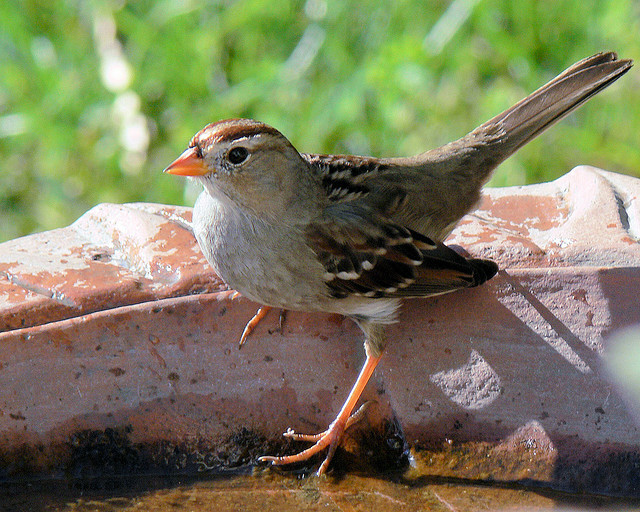One of the things I like best about traveling is hearing different accents, turns of phrase, the variations in cadence and rhythms of speech unique to a specific place. Now that there’s a Starbucks on nearly every commercial district corner, and big box stores are shading out the retail undergrowth, it can be easy to forget you’re away from home until you exchange verbal pleasantries with a local.
Biologists have known for some time that dialects aren’t limited to the human population. Many wild bird species have them too. It can be harder for the untrained human ear to hear, but spectrograms of bird songs show distinct regional, local, and individual variation.
Recently, I learned that a member of my own extended family-of-choice has been traveling to Ecuador to study the dialects of rufous-collared sparrows (Zonotrichia capensis). In the process, Julie Danner—the new wife of my non-biological sister’s nephew—has discovered something about Andean sparrows, as they’re also known, that made even the New York Times take notice: Sparrow chicas are more likely to hook up with homeboys than with chicos who don’t sound like they’re from the ‘hood.
Or, in the language of a scientific journal such as The American Naturalist, where Julie, her husband Ray Danner, and their colleagues at Virginia Tech published their research results, female sparrows “gave significantly more copulation solicitation displays in response to their local dialect than to the song dialects from a population on the other side of an Andean pass (25 km away).”
 The rufous-collared sparrow is the only tropical member of this genus and a close relative of the white-crowned sparrow (Zonotrichia leucophrys) found throughout most of North America. Initially, Julie studied two groups of birds but later expanded to eight populations. Her research suggests as little as 15 miles is enough to produce bird “accents.”
The rufous-collared sparrow is the only tropical member of this genus and a close relative of the white-crowned sparrow (Zonotrichia leucophrys) found throughout most of North America. Initially, Julie studied two groups of birds but later expanded to eight populations. Her research suggests as little as 15 miles is enough to produce bird “accents.”
Recordings of male songs were made at varying distances from a home territory, along with the songs of other bird species. Then Julie put individual females into a holding cage and played the recordings.
“I found out that females distinguish between dialects and prefer the local dialect,” she explains.
Bird dialects seem to be formed by individual birds making slight errors in reproducing the characteristic tune of their species. These errors are picked up by new generations of young males, who don’t know any better, when they’re learning to sing love songs.
Scientists are pretty good describing what is happening in the world (e.g., female sparrows prefer local males) but it’s much harder to explain why. Is there any benefit to females and their offspring when they choose the boy next-door? Julie doesn’t know, but she’s come up with an educated guess.
“A male singing local song could be better adapted to the local environment. He may have better resistance to certain local parasites. A local male may just do better in that environment.” If that’s true, it could increase the likelihood that a female’s offspring will survive.
What’s true for birds is not necessarily true for those who study birds. Julie, who started her doctoral work in 2006 and hopes to finish up next year, is a Connecticut native. Her husband was born and raised over 1000 miles away, in my hometown of St. Louis, Missouri.
Life is better with Next-Life is better with Next-Door Nature—click the “subscribe” link in the lower left-hand corner of the footer and receive notifications of new posts! Have a question about wildlife and other next-door nature? Send me an email and the answer may turn up as a future blog post.
© 2011 Next-Door Nature— no reprints without written permission from the author. Thanks to the following photographers for making their work available through Creative Commons License: Dario Sanches, and Jessica Merz.

I love this blog. I always learn so much, and I remember it because of the entertaining way it is presented. I look forward to each one. Thanks for helping us continue to find awe and inspiration in the life right outside our front door.
Thanks, Deb! I enjoy writing them, but it’s also great to find out that the readers are enjoying themselves too 🙂
the more we learn about creatures, the more unique and smart they show up to be. Information like this always makes me smile.
walk in beauty.
SO true, Joss. A person could spend a whole lifetime studying a single species and never run out of things to learn.
So interesting. Though it’s probably a lot of fun to study the bird in Ecuador, I wonder whether the sparrow’s close relative, the white crowned sparrow, has a similar preference to local boys.
I’ll have to ask Julie if she has plans for a follow-on study of white-crowned sparrows. Seems like a natural next step, but it may depend on whether she can find a grantor who agrees.
You put such a lot of information into your posts and I always learn something new; it’s always a pleasure to come here. We learn so much from nature – it never ceases to amaze me.
Thank you for enlightening us.
Thanks, Barb! Nature never ceases to amaze me either–that’s one of the best things about it 🙂